What did our readers think were our top stories of the year? Rather than do an unscientific poll, we combed through our Google Analytics report and came up with the following.
#1—Healing glass fibers now available for pet and animal treatments
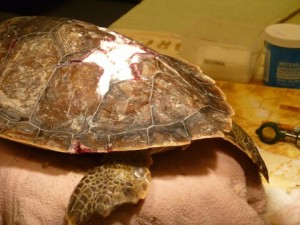
Credit: Rediheal
While the our original story focused on a case study of human patients with venous stasis ulcers, it appears that Dermifuse/Rediheal material works shockingly well on many types of wounds. For example, the Rediheal website has several amazing animal case studies including large and small lacerations, dental void packing, and gunshot wounds. In regard to the gunshot wound case, a dog sustained at 42-square-inch wound on its back that was treated with Rediheal. According the company, the wound shrunk rapidly, and 40 days later it was nearly healed.
#2—Video: Corning on manufacturing optical fiber
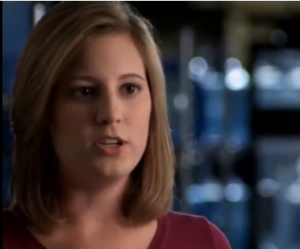
Credit: Corning
Corning’s “At the Speed of Light” is one of the best brief explanations about how optical fiber is made, and one that should be shown in a lot of classrooms. The step-by-step tour takes viewers from the point of conceiving double-layer, core-cladding fibers to development of high purity glass feedstock, and finally to producing miles of fiber via high throughput operations. The video succeeds because Corning let most of the story be told by the engineers and scientists who produce these fibers. Their knowledge and joy for their work comes through.
#3—Video: Corning’s ‘A Day Made of Glass 2: Unpacked. The Story Behind Corning’s Vision’

Credit: Corning
Another Corning video made the top ten list, and the company seems to be making a worthwhile investment in developing its YouTube content. This production was released on the anniversary of its first “A Day Made of Glass” video, and it fleshes out more of Corning’s vision and also incorporates some of the market trends over the last year, such as the huge success of the iPad. Some of the concepts illustrated in the video include durable, multitouch screens; colossal- and large-scale edge-to-edge displays; ubiquitous electrochromic windows; entire dashboard surfaces made of soft, flexible glass displays; lightweight auto and sunroof glass; designer-friendly photovoltaic units; antimicrobial glass services for medical applications; and even advances in glass fiber optics.
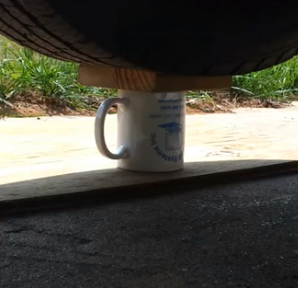
Credit: John Mayo
#4—Texas A&M student puts textbook and ceramic coffee mugs to test
For John Mayo, who was finishing his second year as a mechanical engineering student at Texas A&M, actions speak louder than words. Want to demonstrate how strong ceramic materials can be? Well, then, how about impressing your friends by supporting a pickup truck on four coffee mugs?
A little jacking here and a few blocks of wood there, and presto: Another great video classic for the classroom!
#5—Hot stuff: Measuring thermophysical properties at very high temperatures
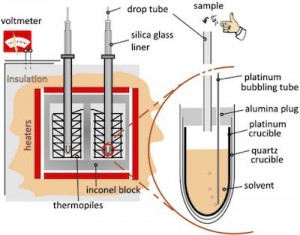
Credit: JACerS; Wiley
All year, Eileen has been tracking developments related to ultrahigh temperature materials and testing (where service temperatures reach more than 1,500°C), a topic driven mostly by aerospace applications, such as hypersonic vehicles and thermal barrier coatings for jet engines, and nuclear energy applications, such as nuclear fuels and accident scenarios. In this post, Eileen reports on a paper in JACerS by Sergey Ushakov and Alexandra Navrotsky that reviews methods for measuring high temperature thermophysical properties. In the paper, the duo says, “The free energy change for a reaction can be calculated if the heat capacities, standard enthalpies and entropies of formation, and enthalpies and temperatures of phase transformations are known for all products and reactants.” But, they go on to observe that such data are often not available at temperatures over 1,500°C, and even when they are, they are subject to revision as better methodologies improve. Eileen notes that Ushakov and Navrotsky say the first essential requirement for measuring high temperature properties is accurate measurement of temperature, and the key is to choose the right method for the temperature regime. Temperatures can be measured by thermocouples or by optical pyrometry, and at these high temperatures, there are subtleties to be aware of with both.
#6—Alta Devices reports NREL verification of 23.5% efficiency for counter-intuitive solar panel

Credit: NREL
Alta Devices is the brainchild of CalTech’s Harry Atwater and University of California at Berkeley’s Eli Yablonovitch, and its innovation is the application of GaAs on thin, flexible film substrates to make thin devices that have the highest energy density possible. Why GaAs? For starters, it can produce a current at high temperatures and in low light. The counterintuitive thing is that although GaAs is relatively expensive, Yablonovitch nevertheless says GaAs is the ideal material for making solar cells because “it absorbs photons 10,000 times more strongly than silicon for a given thickness but is not 10,000 times more expensive.” Besides setting a NREL record, the other good news for the company is that recently it demonstrated a flexible solar charger cover for iPads and similar devices that can deliver 10 watts of power. That’s a lot of juice!
#7—Video: Could graphene-based coating wipe out rust and rejuvenate Rust Belt?
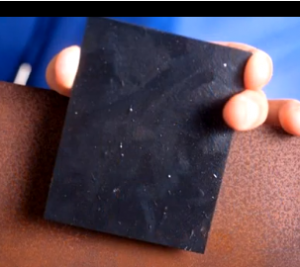
Credit: Univ. of Buffalo
University of Buffalo researchers have developed a graphene-based coating that acts as an active and passive corrosion prevention barrier and can be applied using standard, off-the-shelf industrial tools. So what? Well, for starters, corrosion costs industrialized nations approximately 3 percent of their gross domestic product or about $2-4 trillion in the US each decade. The coating is a polyetherimide matrix with a graphene filler dispersion. The polymer is a common industrial polymer, and its role in the coating is to provide adhesion with the steel as well as to provide thermal and chemical stability. The coating is effective because of it is both an active and passive coating. “It is passive in that it prevents water ions from reaching the steel,” explains UB associate professor, Sarbajit Banerjee. “We also think it works as an active coating by setting up a Shottkey barrier that depletes electrons and shuts down the electrochemistry at the interface.” Importantly, the new coating could be an effective replacement for hexavalent chromium corrosion-prevention coatings, which have been linked to cancer-causing pollution.
#8—Video: Performance art with dormitory windows

Credit: G. Raymond
Another video! And, something about this creative stop-action video—made by coordinating the opening and closing of dorm room shutters on a campus in Switzerland—reminded Eileen of crystal structures and the motion of atoms, electrons, ions, holes, phonons, through a “rigid” framework. The building also seems to come alive!
#9—Hell’s kitchen: Thermal stress and glass cookware that shatters
This was the post where we first announced the results of R.C. Bradt and R.L. Martens research— which was soon to appear in ACerS’ Bulletin—about the apparent causes of the scattered reports of explosion like failures of transparent glass cookware used in the US. The story was recently picked up by NBC News, whose reporters investigated the claims and found reports to the Consumer Product Safety Commission to be on the upswing.
#10—New ceramic-aluminum composite brake rotor developed for mass market

Credit: NYU-Poly
Ceramic brake rotors have been common for some time in race-oriented cars and motorcycles, and also in premium-priced commercial automobiles, and are slowly making its way into mass-market vehicles and aftermarket parts dealers. But the technology behind the current generation of ceramic braking systems isn’t all that it could be, and a team of researchers from Polytechnic Institute of New York University and Michigan-based REL Inc. say they have created a next-generation aluminum-ceramic composite brake rotor that may cut rotor weight 60 percent. The team also says the new rotor’s functionally graded design could triple the lifespan of traditional rotors. A functionally graded design is of interest because of nonuniform temperatures and pressure strains across the surface of the rotor. Instead, they say the optimal brake rotor needs to be designed with three functional regions, where each region is matched to a material with distinct strain and thermal properties.
